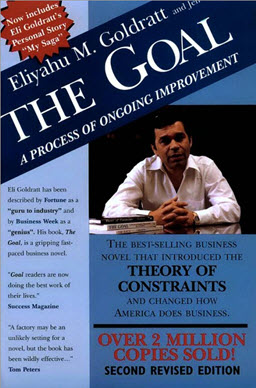 The Goal by Eliyahu M. Goldratt was brought to my attention when my director came out to discuss our operations team and ask where the bottlenecks in our organisation lay. When he referred to Herbie, I had to know what he meant.
The Goal by Eliyahu M. Goldratt was brought to my attention when my director came out to discuss our operations team and ask where the bottlenecks in our organisation lay. When he referred to Herbie, I had to know what he meant.
The first thing to note about this book is that it is a story, not your normal dry textbook style business book. I guess teaching through narratives worked for the Bible, so why not a business book? It is a tricky balance though, and I feel at some points the author gets a little distracted by the back story. To make up for this he then compresses a number of key points into one paragraph of wise dialogue. It all flows reasonably well overall, it just means you can’t start skimming what appears to be light reading or you might miss key insights.
So what are the morals? The story starts with plenty of despair and common frustrations, but I love that it also starts with a reasonable company making reasonable decisions – yet everyone is burned out and under resourced. In my experience this is an incredibly common situation and probably where the “work smarter, not harder” phrase comes from. Even though the book sets its story in a manufacturing plant I found it really easy to adapt to my experience, especially working with an Agile software development team.
The solutions expressed in the book are all about a back to basics approach to finding and optimising within your constraints. Every process has a bottleneck, the trick is identifying what it is and then applying techniques to make the best of what you have. For example, if your developers are constantly overworked then test the requirements documents before they start work and offload some of their tasks to other roles who are not bottlenecks. Sounds simple right? To justify these changes to your accountant you can note that if your developer works 50 hours a week and your total operating expenses for a week are $50,000 then the cost of them wasting an hour is $50,000 divided by 50 – $1,000. This is because it adds downtime and inventory jams across the rest of your process and is the limiting factor of overall output. Puts things in perspective right?
The book doesn’t stop there however – it talks about synchronising bottlenecks and non-bottlenecks, the importance of minimising inventory, how to focus on market demand across your organisation, why data is misleading and no substitute for getting out on the floor, problems with modern efficiency accounting practices and even how organising a regular “date night” with your partner is a good idea! Overall I really loved this book, it was very easy to read and relate to. Although it doesn’t mention this, I think it is a great read for fast growing companies that face resource constraints every day and can get easily distracted by their purpose as a company.

Leave a Reply